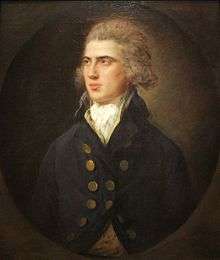Robert Adair (politician)
| Robert Adair | |
|---|---|
 | |
| British Ambassador to Belgium | |
|
In office 1831–1835 | |
| Monarch | William IV |
| Preceded by | John Ponsonby |
| Succeeded by | Stratford Canning |
| British Ambassador to the Ottoman Empire | |
|
In office 1808–1809 | |
| Preceded by | Sir Arthur Paget |
| Succeeded by | Henry Bulwer |
| British Ambassador to Austria | |
|
In office 1806–1807 | |
| Monarch | George III |
| Prime Minister | William Cavendish-Bentinck |
| Preceded by | Sir Arthur Paget |
| Succeeded by | George Herbert |
| Member of Parliament for Camelford | |
|
In office 1802–1812 | |
| Preceded by | William Joseph Denison |
| Succeeded by | John Angerstein |
| Personal details | |
| Born | May 24, 1763 |
| Died | October 3, 1855 (aged 92) |
| Political party | Whig |
| Spouse(s) | Angélique Gabrielle (m. 1805) |
| Alma mater |
Westminster School University of Göttingen |
Sir Robert Adair GCB (24 May 1763 – 3 October 1855) was a distinguished English diplomat, and frequently employed on the most important diplomatic missions.
He was the son of Robert Adair, sergeant-surgeon to George III, and Lady Caroline Keppel, daughter of Willem Anne van Keppel, 2nd Earl of Albemarle. He was educated at Westminster School and the University of Göttingen, and then studied law at Lincolns Inn, but hardly practised as a barrister.
He hoped to gain office as Under-secretary of State to Charles James Fox, but he was in opposition. Following the French Revolution, he travelled in Europe, visiting Berlin, Vienna, and St Petersburg to study the effects of the revolution and equip himself for a diplomatic career.
He became Whig Member of Parliament (MP) for Appleby (1799–1802) and Camelford (1802–12).
In 1805, he made a disastrous marriage to Angélique Gabrielle, daughter of the marquis de l'Escuyer d'Hazincourt (known as ‘Talleyrand's spy’), but this kept him out of office when Fox returned to government. Instead Fox sent him to Vienna. In June 1808, George Canning transferred him to Constantinople. He was created a KCB in that year for his services there. He was appointed a Privy Counsellor in 1828.
He was employed in Belgium from 1831 to 1835, where he succeeded in preventing a war between the Flemish and Dutch troops. This exploit won for him the rank of GCB and a pension of £2000 per year from 1831. He then visited Prussia. In the 1840s, he published memoirs of his diplomatic activities in the 1800s.
References
- W. P. Courtney, 'Adair, Sir Robert (1763–1855)', rev. H. C. G. Matthew, Oxford Dictionary of National Biography (Oxford University Press, 2004; online edition, January 2008) [1]
- ↑ Oxford Dictionary of National Biography , accessed 23 September 2008
External links
- Hansard 1803–2005: contributions in Parliament by Robert Adair
- Portraits of Robert Adair at the National Portrait Gallery, London

| Parliament of Great Britain | ||
|---|---|---|
| Preceded by John Tufton John Courtenay |
Member of Parliament for Appleby 1799–1800 With: John Courtenay |
Succeeded by Parliament of the United Kingdom |
| Parliament of the United Kingdom | ||
| Preceded by Parliament of Great Britain |
Member of Parliament for Appleby 1801–1802 With: John Courtenay |
Succeeded by Sir Philip Francis John Courtenay |
| Preceded by William Joseph Denison John Angerstein |
Member of Parliament for Camelford 1802–1812 With: John Fonblanque 1802–1806 Viscount Maitland 1806–1807 Lord Henry Petty 1807–1810 Henry Brougham 1810–1812 |
Succeeded by William Leader Samuel Scott |
| Diplomatic posts | ||
| Preceded by Sir Arthur Paget |
British Minister to Austria 1806–1807 |
Succeeded by The Earl of Pembroke and Montgomery |
| Preceded by Sir Arthur Paget |
British Ambassador to the Ottoman Empire 1808–1809 |
Succeeded by Stratford Canning Chargé d'Affaires |
| Preceded by The Lord Ponsonby |
British Ambassador to Belgium 1831–1835 |
Succeeded by Henry Lytton Bulwer Chargé d'Affaires |